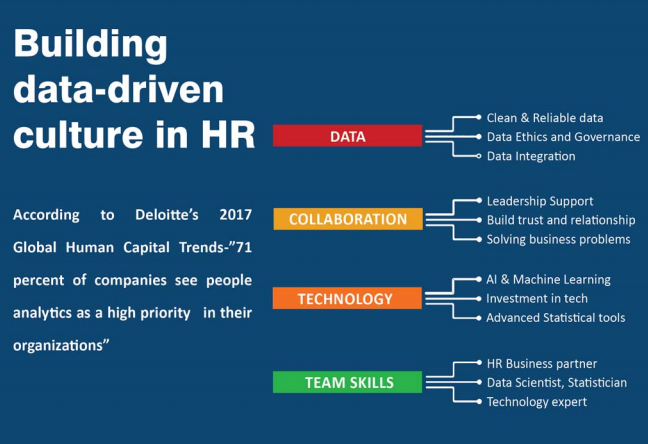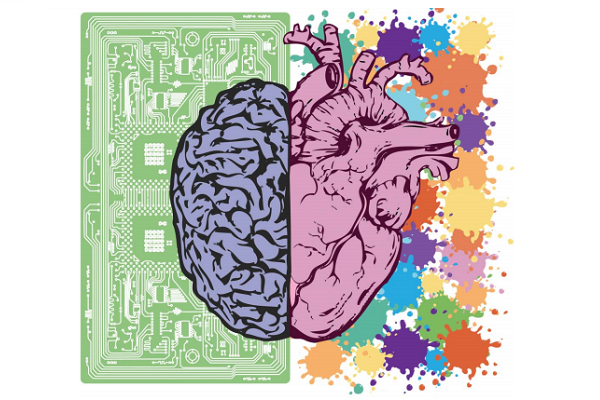HR can play a game-changer role in the transformational journey with basic data literacy and analytics training. It's essential to train employees on how data insights are generated, how they can be applied, how to identify the target audience and prioritise business problems to be solved.
HR is experiencing a significant shift from a transactional to a transformational role. Digital transformation has catapulted many organisations to invest in technology that leverages data effectively, and the HR function is not behind. People analytics collect, clean, and make sense of talent data by deriving statistical insights to make the right decision about people, further improving business outcomes. It is a journey from what has happened in the past to what may happen in the future.
According to LinkedIn Global Talent Trends 2020 – “People Analytics” was one of the top four trends, changing the way you attract and retain talent.
During the COVID pandemic, People Analytics helped make crucial decisions around employee experience by catering to employees’ well-being, safety, the impact of remote work, and their return to the workplace. With a massive demand for information about what makes employees happy, what makes them stay or leave, what improves productivity, or what creates engagement, People Analytics’s growth is inevitable. It’s one of the in-demand skills HR professionals want to learn.
In addition to statistical tools like SPSS, R or Excel, which provide basic correlation, regressions, etc., advanced technology of Artificial Intelligence and Machine Learning is rapidly transforming data analytics. It has enabled collecting, storing, and processing voluminous data to identify patterns and trends, provide solutions to difficult problems, and predict future outcomes. Companies like Unilever, Microsoft, Google, IBM, and, many more extensively use advanced people analytics to manage their workforce to stay ahead in the talent competition.
Why we need People Analytics in HR function?
HR function needs to move ahead from metrics to insights to improve people and business decisions, just like reporting numeric attrition rate to predict attrition to take corrective measures on time. Here’s how it can make a difference-
Recruitment
Apart from Operational Reporting, data-driven recruiting backed by AI & ML can improve hiring metrics like time to hire, cost to hire, and quality of hire. It can optimise recruitment cost by identifying the most effective source or channel - job portals, LinkedIn, career pages, employee referral, social media etc., for quality candidates. It can predict candidates’ future performance based on past credentials and assessment scores or a passive candidate’s turnover rate when reached out by considering data points like social media posts, skillset, experience, recommendations, etc. You can enhance your employer brand and candidate experience through 24 * 7 digital assistance in the form of chatbots that can reduce application drop rate by answering FAQs about role and company using Natural Language Processing. Automated sourcing, matching, and ranking candidates is possible using ML algorithms based on data points.

Learning & Development
With the demand for an agile workforce, building employees’ capability has become a priority for all organisations. With the emphasis on digital learning, post-Covid, LMS & other AI-backed tools have emerged, providing reporting and analytics for L & D performance measurement and evaluation. People analytics can help recommend a personalised training program based on skill gaps, career paths, or needs for upskilling, reskilling, or cross-functional skilling of employees.
The number of logins or time spent by employees on LMS can indicate how engaged employees are in recommended programs or which courses add value to employees’ skillset. The quality of learning content and experience can be continuously evaluated by referring to employee feedback, the number of attendees, test scores, completion rate, the preferred mode of delivery - presentations, instructor-led, e-learning, etc. Learning data insight can further help to improve the learning experience of employees.
Continuous Performance Management, Engagement and Retention
Real-time data analytics for evaluating performance has enabled managers to continuously provide timely feedback to employees, identify skill gaps and boost their career growth. The engagement level of employees can be determined by leveraging data extracted from employee satisfaction or engagement surveys, performance ratings, absenteeism, turnover rates or stay interviews.
You can predict attrition by correlating with data points like age, tenure in company and role, engagement survey results, compensation, years since last promotion, performance rating, job satisfaction, travel time, etc., as to which employees may leave, when, and why. Data points like reported reason or tenure from exit interviews can be utilised to determine what causes employee turnover and what corrective actions can be taken on time to build retention strategy using data to prevent high turnover cost and save high performing employees.
How to build a data-driven culture in HR
According to Deloitte’s 2019 “Becoming an insight-driven organization survey” - Organisations with the strongest cultural orientation to data-driven insights and decisionmaking were twice as likely to have significantly exceeded business goals.”
People Analytics helps organisations to quantify the relationship between people and business outcomes. It’s essential to develop a culture where data-driven metrics and insights get more credibility to solve business problems. To have a data-driven culture in HR, below mentioned aspects are crucial to delivering business value.
Data:
The quality of the data input for analysis plays a prime role in deriving meaningful insights. Clean and reliable data with accuracy and consistency is food for data processing. Data sources utilized by HR for analytics include employee data (demographics), annual employee engagement or satisfaction surveys, performance ratings, payroll data, HRIS, ATS reports on recruitments, etc.
Data security and privacy are of utmost importance as employees’ or candidates’ data must be handled responsibly. Data governance with a data ethics charter should be in place to guide how employee data is collected, analyzed, stored, used, and distributed to the concerned team for the required task only. Data-driven culture will get a push if employees have trust in what you are doing with their information, what business problems it will solve, the expected outcome, and how you will measure the success of insights or recommendations given to people and business.
People analytics is collecting data and integrating employee data with other business data to generate actionable insights. For example - employee engagement directly correlates with employee performance, which ultimately affects the business outcomes like sales, pre and post-training performance of the sales team by evaluating change in sales figures. Data in silos may not serve the purpose of analysis and must be integrated with other business functions to answer relevant business questions.
Collaboration between HR and Business :
A data-driven culture is impossible without the support of a leadership team that is deeply convinced with People Analytics’ potential and its need for business success. HR needs to build bridges and nurture trust relationships with internal business functions (IT, Finance, Operations, Sales & Marketing etc.) or teams, even external vendors if required to push data-driven decisions.
HR must demonstrate evidence-based discussions to key stakeholders on how exactly data can make each function or team more effective and efficient. Start with small data projects which directly affect business and execute them well to get buy-in from leadership. The basis should be solving business problems and whether the business is ready to take action based on insights. Your culture should reward data-driven thinking for finding solutions to business challenges.
Technology:
With volumes of data available now, advanced software, AI, ML, and RPA, have enhanced predictive and prescriptive analytical capability. Machine Learning Algorithms based on data points help to identify patterns and create a personalized experience for employees. As per a study by Nucleus Research - the return for investing in analytics was $13.01 for every dollar invested. Investing in better technology as per needs to analyze data will push the usage of data by HR to derive insights and save on time or efforts.
People analytics team with multidisciplinary skills:
A right mix of a team with HR business partners, data scientists, researchers, statisticians, consultants, and technology experts is the key to establishing people analytics function in an organization. The team should be competent enough to develop a hypothesis, convert data into actionable insights, communicate through data storytelling or data visualization and give data-driven predictions or recommendations to the business at the right time.
HR can play a game-changer role in the transformational journey with basic data literacy and analytics training. It’s essential to train employees on how data insights are generated, how they can be applied, how to identify the target audience, prioritise business problems to be solved, etc. It can create more awareness of practical aspects of data analytics functionality, cultivating a culture driven by data.
Implementing People Analytics or developing a data-driven culture is certainly not an easy path with challenges around data quality, culture barriers, skill gaps, technology, data communication, leadership support, and investments. But, if organizations want to make people a source of competitive advantage and want to attract, develop, and retain high-performing employees, they will have to unlock the power of data to make talent decisions that can make their business a success. People analytics can impact all key stakeholders by utilising the employee life cycle data to derive insights that can drive revenue, making HR a strategic partner like other business functions.
Is your organisation post-COVID-ready?
Trending
-
SBI General Insurance Launches Digital Health Campaign
-
CredR Rolls Out 'Life Happens' Leave For Its Employees
-
Meesho Announces 30-Week Gender-Neutral Parental Leave Policy
-
Microsoft Unveils Tech Resilience Curriculum To Foster An Inclusive Future
-
60% Indian Professionals Looking For Job Change Due To COVID: Survey
-
SpringPeople And Siemens Collaborate For Digital Transformation Push
-
86% Professionals Believe Hybrid Work Is Essential For Work Life Balance: Report
-
Almost 1 In Every 3 People's Personal Life Affected Due To Work Stress
-
Meesho Rolls Out Reset And Recharge Policy For Employees
-
80% Of Talent Leaders & Academics Say Pandemic Changed Skill Needs For Youth: Report
-
Hero Electric Rolls Out 'Hero Care' Program For Employees
-
Human Capital In Collaboration With ASSOCHAM Hosts Virtual Conference
-
IKEA India, Tata STRIVE Collaborate To Create Employability And Entrepreneurship Opportunities
-
SAP India, Microsoft Launch Tech Skilling Program for Young Women
-
DXC Technology, NASSCOM Collaborate For Employability Skills Program
-
Lenskart To Hire Over 2000 Employees Across India By 2022
-
Mindtree Launches Learn-and-Earn Program
-
Tata AIA Extends 'Raksha Ka Teeka' To Its Employees
-
Swadesh Behera Is The New CPO Of Titan
-
NetConnect Global Plans To Recruit 5000 Tech Professionals In India
-
Hubhopper Plans To Hire 60% Of Indian Podcasters By 2022
-
Corporate India Needs More Women In Leadership Roles: Report
-
Aon to Invest $30 Million and Create 10,000 Apprenticeships by 2030
-
Tech Mahindra Launches ‘Gift a Career’ Initiative for Upskilling of Youth
-
40% Women Prefer Flexible Working Options in Post-COVID World: Survey
-
3 out of 4 companies believe they can effectively hire employees virtually: Report
-
Vodafone , CGI and NASSCOM Foundation launch digital skills platform
-
Odisha: Bank, postal employees to deliver cash for elderly, differently-abled persons
-
Skill India launches AI-based digital platform for "Skilled Workforce"
-
Hiring activity declines 6.73% in first quarter: Survey
-
70% startups impacted by COVID-19 pandemic
-
Bajaj Allianz Life ropes in Santanu Banerjee as CHRO
-
Over 70 Percent MSMEs look at cutting jobs to sustain businesses
-
93 Per Cent employees stressed about returning to office post-lockdown
-
Johnson & Johnson India announces family benefits for same gender partners
-
Indian firms turning friendly towards working mothers
-
Welspun India names Rajendra Mehta as new CHRO
-
Wipro partners with NASSCOM to launch Future Skills platform



Human Capital is niche media organisation for HR and Corporate. Our aim is to create an outstanding user experience for all our clients, readers, employers and employees through inspiring, industry-leading content pieces in the form of case studies, analysis, expert reports, authored articles and blogs. We cover topics such as talent acquisition, learning and development, diversity and inclusion, leadership, compensation, recruitment and many more.
Subscribe Now












































Comment